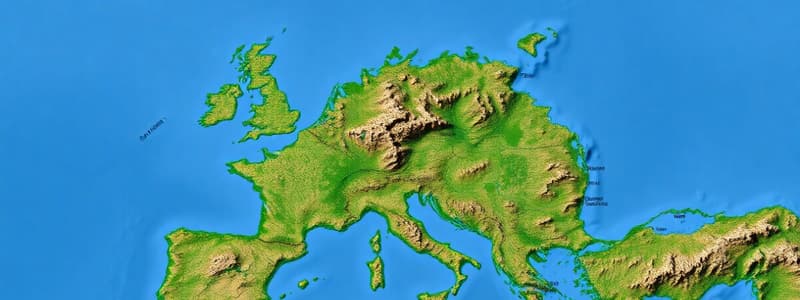Podcast
Questions and Answers
Which of the following best defines georeferencing?
Which of the following best defines georeferencing?
- The process of associating data with a specific location on Earth using coordinate systems (correct)
- Determining the exact time a location was created
- The process of measuring distances on the Earth's surface
- The ability to project 3D objects onto 2D surfaces
Geographic Coordinate Systems can accurately compute areas and distances.
Geographic Coordinate Systems can accurately compute areas and distances.
False (B)
What is the range of longitude values?
What is the range of longitude values?
from 0° at the Prime Meridian to ±180°
The ____ projections preserve area but distort shape.
The ____ projections preserve area but distort shape.
Match the following projection types to their properties:
Match the following projection types to their properties:
Which term refers to a line of constant latitude?
Which term refers to a line of constant latitude?
All map projections equally preserve area, shape, and distance.
All map projections equally preserve area, shape, and distance.
What is the purpose of map projections?
What is the purpose of map projections?
Which map projection preserves area but distorts shape, distance, and direction?
Which map projection preserves area but distorts shape, distance, and direction?
The Orthographic projection simulates viewing the Earth from its center.
The Orthographic projection simulates viewing the Earth from its center.
What type of coordinate system divides the globe into 60 zones, each 6° wide?
What type of coordinate system divides the globe into 60 zones, each 6° wide?
The ________ projection is known for preserving distances and directions from a central point.
The ________ projection is known for preserving distances and directions from a central point.
Match the following map projections to their properties:
Match the following map projections to their properties:
Which projected coordinate system uses meters for coordinating locations?
Which projected coordinate system uses meters for coordinating locations?
The State Plane Coordinate System is designed to minimize distortion across the globe.
The State Plane Coordinate System is designed to minimize distortion across the globe.
What is the main difference between a Geographic Coordinate System (GCS) and a Projected Coordinate System (PCS)?
What is the main difference between a Geographic Coordinate System (GCS) and a Projected Coordinate System (PCS)?
Flashcards
Georeferencing
Georeferencing
The process of associating data with a specific location on Earth using coordinate systems.
Uniqueness
Uniqueness
Locations must be uniquely identifiable, meaning no two places can have the same location.
Spatial Resolution
Spatial Resolution
The level of detail in defining a location, showing how specific it is.
Metric Georeferencing
Metric Georeferencing
Signup and view all the flashcards
Latitude
Latitude
Signup and view all the flashcards
Longitude
Longitude
Signup and view all the flashcards
Map Projection
Map Projection
Signup and view all the flashcards
Equal-Area Projection
Equal-Area Projection
Signup and view all the flashcards
Gnomonic Projection
Gnomonic Projection
Signup and view all the flashcards
Stereographic Projection
Stereographic Projection
Signup and view all the flashcards
Orthographic Projection
Orthographic Projection
Signup and view all the flashcards
Tangent Case
Tangent Case
Signup and view all the flashcards
Secant Case
Secant Case
Signup and view all the flashcards
Albers Equal Area Projection
Albers Equal Area Projection
Signup and view all the flashcards
Lambert Conformal Conic Projection
Lambert Conformal Conic Projection
Signup and view all the flashcards
Projected Coordinate System (PCS)
Projected Coordinate System (PCS)
Signup and view all the flashcards
Study Notes
Introduction to Georeferencing
- Georeferencing associates data with a specific location on Earth using coordinate systems
- Enables geographic information systems (GIS) to accurately map features
Key Properties of Georeferencing Systems
- Uniqueness: Locations must be uniquely identifiable, like differentiating locations with the same name (e.g. Springfield, MO vs Springfield, UK)
- Persistence: Locations remain consistent over time
- Spatial Resolution: Specifies level of detail (e.g. "Norman" is more precise than "Oklahoma")
- Metric vs. Non-Metric:
- Metric: Uses coordinate systems for distance calculations (e.g., latitude/longitude)
- Non-Metric: Uses relative locations (e.g., "next to the river")
Geographic Coordinate System (GCS)
- Uses latitude and longitude lines to define locations
- Components:
- Latitude (Parallels): Measures north-south position, ranging from 0° at the equator to ±90° at the poles
- Longitude (Meridians): Measures east-west position, ranging from 0° at the Prime Meridian (Greenwich, England) to ±180°
- Units: Angular degrees, minutes, and seconds (or decimal degrees)
- Example: Norman, Oklahoma = 35°13'N, 97°26'W
- Terms to Remember:
- Meridian: Line of constant longitude
- Parallel: Line of constant latitude
- Unprojected Nature of GCS: Cannot accurately calculate areas or distances without projection
Map Projections
- Converts Earth's 3D surface to a 2D map
- Introduces distortions
Projection Properties
- Equal-Area (Equivalent): Preserves area, but distorts shape
- Conformal (Orthomorphic): Preserves shape, but distorts area
- Equidistant: Preserves distances (only in specific areas)
- True-Direction (Azimuthal): Preserves angles/directions
- Compromise: Balances distortion among properties
Projection Factors
- Developable Surfaces: Shapes onto which Earth is projected
- Cylindrical: Gridlines form rectangles (e.g., Mercator)
- Conical: Gridlines curve (e.g., Albers Equal Area)
- Planar: Gridlines radiate from a central point (e.g., Azimuthal)
- Aspect: Orientation of the developable surface
- Normal: Aligned with the poles
- Transverse: Aligned with the equator
- Oblique: At an angle
- Viewpoint: Light source for projection
- Gnomonic: From the Earth's center
- Stereographic: From the far side of the globe
- Case: Intersection of developable surface with Earth
- Orthographic: From infinity
- Tangent: Touches at one line or point
- Secant: Cuts through the Earth
Common Map Projections
- Albers Equal Area: Preserves area, distorts shape, distance, and direction; Conic projection; used for regional/national maps
- Lambert Conformal Conic: Preserves shape and direction, distorts area; Conic projection; used for navigation, State Plane Coordinate System
- Mercator: Preserves direction and shape; distorts area at high latitudes; Cylindrical projection; used for navigation, world maps
Projected Coordinate Systems (PCS)
- Grid superimposed on a map projection, specifying locations in a plane
- Components:
- Ellipsoid: A mathematical model of Earth's shape (e.g., GRS80, WGS84)
- Datum: Links ellipsoid to specific Earth locations (e.g., NAD83)
- Projection: Converts 3D Earth to 2D coordinates
- Common PCSs:
- Universal Transverse Mercator (UTM): Divides globe into 60 zones, uses meters for coordinates, popular for GPS mapping
- State Plane Coordinate System (SPCS): Divides states into zones, uses different projections to minimize distortion (Lambert or Mercator)
Practical Applications
- GCS vs. PCS:
- GCS (latitude/longitude) is suitable for global contexts
- PCS (projected) allows accurate distance, area, and direction measurements
- Choosing the right projection depends on map purpose
- Preserve area for population density
- Preserve distance for transportation
- Preserve direction for navigation
Studying That Suits You
Use AI to generate personalized quizzes and flashcards to suit your learning preferences.




